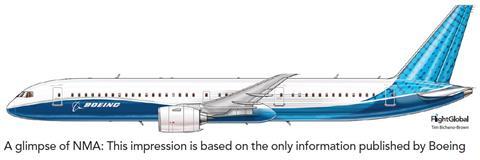Aerospace analysts are increasingly in agreement that Boeing must build a new narrowbody jet – lest it lose a huge chunk of valuable market share to competitor Airbus.
Speaking during PNAA Advance, an event hosted by the Pacific Northwest Aerospace Alliance, the analysts expressed the same sentiment: Boeing has little choice but to strike back against Airbus.

“If Boeing does nothing, this is an enormous chunk of the market that is lost to them,” Teal Group analyst Richard Aboulafia said on 10 February. “There’s a huge threat here, but also a huge opportunity.”
“We still see a need for a [new mid-market aircraft] considering the current gap in the product line-up,” adds Michel Merluzeau, analyst with aerospace consultancy AIR.
Kevin Michaels with consultancy AeroDynamic Advisory said essentially the previous day: “Boeing needs to relaunch a white-sheet [design].”
The comments come several weeks after Boeing chief executive David Calhoun said his company was still evaluating whether to launch a new “mid-market” jet. Such an aircraft would check Airbus’s A321neo and replace old 757s.
Airlines began clamouring for narrowbodies with extended range even before the pandemic decimated air travel last year. And as the industry recovers, analysts suspect airlines will need more such aircraft.
Aboulafia calls the trend “a secular shift away from twin-aisles to single-aisles”. He says “Airbus is clearly pulling ahead”.
Airbus has seen strong sales for A321neos, particularly for two longer-range variants: the 4,000nm (7,400km)-range A321LR and the in-development, 4,700nm-range A321XLR.
Airbus holds about 3,000 A321neo orders, according to Cirium fleet data.
By comparison, Boeing holds orders for about 460 737 Max 10, which aligns most-closely with the A321neo but carries fewer passengers and has less range, about 3,300nm.
Aboulafia views the A321neo as the aircraft that will enable Airbus in the coming decade to capture 60% of large airliner market, up from about 50% today.
The A321neo “becomes the wedge by which [Airbus] gets to 60%,” he says. “It is really tough to recover a market share drop like that.”
Still, Aboulafia gives Boeing only a 40-45% chance of actually pulling the trigger on a new mid-market aircraft.
“Our assumption is that Boeing does not do anything,” he says.


























